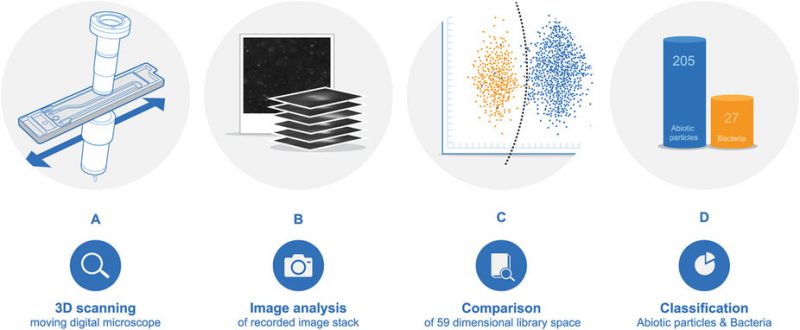On-line Bacteria Sensor for Monitoring Drinking Water Quality
Published on by Water Network Research, Official research team of The Water Network in Technology
A novel, optical, on-line bacteria sensor with a 10-minute time resolution has been developed. The sensor is based on 3D image recognition, and the obtained pictures are analyzed with algorithms considering 59 quantified image parameters
One of the major challenges in ensuring safe drinking water is the difference between the time it takes to produce, distribute, and consume the water, and the time it takes to investigate whether it is safe to drink it. In drinking water some of the major health risks are constituted by microorganisms either coming from the water source, entering storage or distribution systems unintendedly or growing in the water. Unfortunately, by the time routine microbial analysis reveals a possible bacterial pollution, the investigated water has often already been distributed and consumed.
 Water utilities are required to verify the water quality on a regular basis, applying standard methods at predetermined sampling frequencies. These methods are typically growth-based, laborious and time-consuming, giving answers one to three days later and merely providing point information without insight into temporal development. Further, application of heterotrophic plate count methods only reveal a fraction of the total population present in drinking water as they do not include viable, but non-culturable bacteria.
Water utilities are required to verify the water quality on a regular basis, applying standard methods at predetermined sampling frequencies. These methods are typically growth-based, laborious and time-consuming, giving answers one to three days later and merely providing point information without insight into temporal development. Further, application of heterotrophic plate count methods only reveal a fraction of the total population present in drinking water as they do not include viable, but non-culturable bacteria.
Automating existing technology for on-line detection of bacteria, e.g. flow cytometry, or indirect indicators of bacterial activity, such as ATP14, have been given much attention over the past years. A great deal of effort has also been put into the development of sensors that sense bacteria by direct contact with the sensor surface15,16,17. Unfortunately, these solutions are either complicated to operate, require addition of chemicals, daily or weekly maintenance, or are too expensive to be deployed throughout distribution networks. The contact type sensors further encompass the probability of a bacterium actually touching the sensor surface. Considering the relatively low concentration of bacteria in drinking water, this probability may be very low.
Since many parameters in drinking water systems may vary significantly, spatially and timely, it is likely that routine monitoring with lab sampling will fail to catch short-term pollutions. Consequently, major utilities often increase the number of analyses beyond the requirements and supplement their data with on-line measurements of turbidity, conductivity, etc. Since such parameters respond to more than just bacterial content, they are likely to show false positives as well as false negatives in terms of microbiological pollution detection.
Conclusively, the delay and limitations associated with current growth-based methods and the missing specificity of current on-line methods make it practically impossible to proactively react on contamination events in today’s drinking water distribution systems. What seems to be missing in this technology gap is a compromise between the two extremes: A sensor that may have a longer response time than the indirect sensors (pH, conductivity, etc.) and may be far less specific than the laboratory-based methods, but instead provides valuable information on the dynamics of bacteria concentrations in general. For such a sensor to be applicable in remote locations, e.g. throughout a drinking water distribution network, it should need as little maintenance as possible, should not require chemical supplies, and should not create hazardous waste.
In this paper, we present a rapid, chemical-free method for on-line monitoring of non-specific bacteria in water with a 10-minute time resolution, based on 3D scanning by a moving digital microscope. We aim to prove the sensor concept, demonstrating its applicability to distinguish between microbial and abiotic particles, and detect variations so fast that it enables proactive actions to potential pollution events, thus providing a new tool for risk management in drinking water applications. The ability of the method to quantify particles, measure their size and eccentricity, and classify them as either bacteria or abiotic particles, has been proved through laboratory tests. The applicability and robustness of the method in on-line monitoring have been demonstrated through field tests. Various drinking water systems have been monitored by the method revealing both stable base lines and responses to various events.
Source: nature.com
Read More Related Content On This Topic - Click Here
Media
Taxonomy
- Water
- Technology
- Monitors
- IT
- Water Monitoring